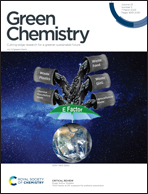Compartmentalization of a synergistic fungal-bacterial consortium to boost lactic acid conversion from lignocellulose via consolidated bioprocessing
Abstract
Consolidated bioprocessing (CBP) is a promising approach to directly convert lignocellulose feedstocks into targeted biochemicals and biofuels, and is commonly executed by single engineered microorganisms. Alternatively, the complex metabolic functions can be compartmentalized into different specialized microorganisms by using microbial consortia. In this study, a simplified microbial consortium was re-assembled consisting of the lignocellulose degrader Trichoderma asperellum and lactic acid (LA) producer Lactobacillus paracasei, which were derived from the same native microbial consortium. The novel strategy of “learning from nature” combined with “simplifying the native microbial consortium” successfully increased cellulosic LA production from 7.36 g L−1 (native microbial consortium) to 57.57 g L−1 owing to the members’ co-operation. Especially, over 80% carbon flux flowed from Avicel into LA synthesis with a yield of 0.92 g g−1. Furthermore, these two members can co-exist after compartmentalization into different spatial structures based on an aggregated granule of hydrogel-embedded L. paracasei and the formed biofilm of T. asperellum, leading to a 29.41% increase of LA productivity. This successfully constructed microbial consortium creates individual ecological niches to meet different oxygen demands, which enables more efficient co-operative performance in LA production from lignocellulose biomass. The analysis of interactions between these two members also provides insights on synthetic microbial consortium construction for the synthesis of other chemicals.



 Please wait while we load your content...
Please wait while we load your content...